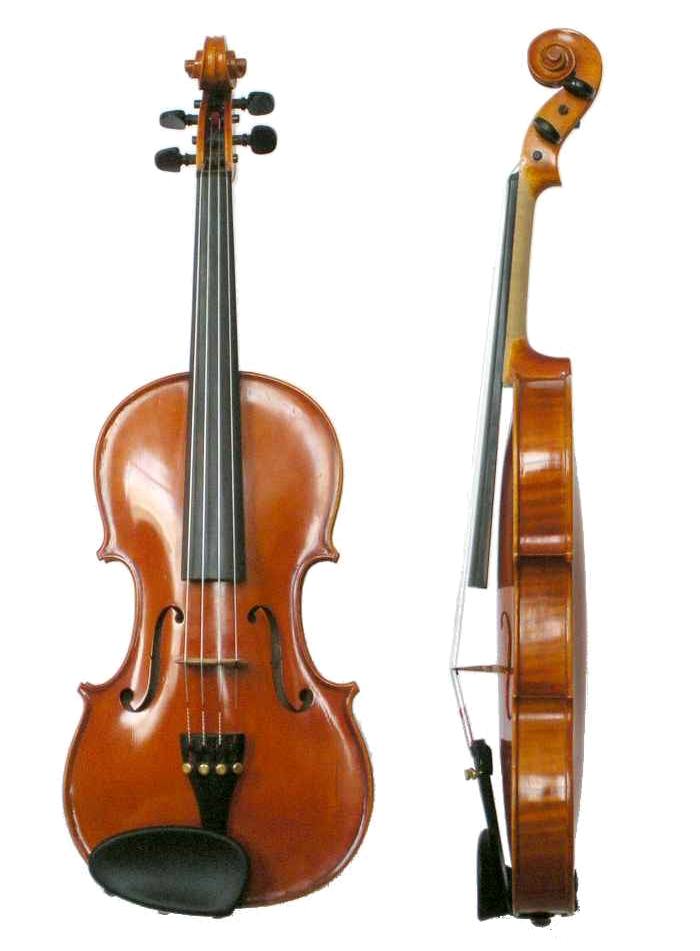
Fiddle
#history
The genealogy that leads to today's violin is more complex. It is found in the rubbing of the strings of the lute and the rebab —and its European version, the rebel—, instruments widespread in Mediterranean Europe during the medieval expansion of Arab culture. In Italy, from the Byzantine lyre or the rebab, the most obvious antecedents emerge, both of the violin and the so-called viola da gamba; such precedents are the viola de arco (a name that was used for any stringed instrument rubbed with a bow, such as the rebel chamois, and which also receives the names of viela, vihuela, vihuela de bow, fidula and giga) and the lyre or viola da braccio, is already very similar to a primitive violin or viola, although with the fingerboard separating the chords. It was in the 16th century that the violin itself appeared, although with some differences compared to most violins that have been manufactured since the 19th century. The top cover and side boards are made of soft wood, while the bottom cover is made of hardwood. In northern Italy, the city of Cremona was located between a fir (soft wood) and a maple (hardwood) forest, so these woods were used by the great guitar masters. The bow has undergone many modifications. The current model dates back to the 19th century, when François Tourte gave it a concave curvature, which in the most primitive models was convex, like that of the hunting bow.[13]
Genealogy of the violin according to the Encyclopedia Britannica (vol. 7, page. 514, 11.1st ed., 1911).
Although in the 17th century the violin (violin) was quite widespread in Italy, it lacked any prestige (the lute, the vihuela, the viela, the viola da gamba, the guitar, the mandolin were much more considered). However, Claudio Monteverdi is one of those who discover the possibility of the sound qualities of the violin, and that is why he uses it to complement the choral voices in his opera Orfeo (1607). Since then, the prestige of the violin began to grow. Around that time certain violin manufacturers began to become known (still called luteros or lauderos, or luthiers —more often than violeros— since they initially dedicated themselves to the manufacture of lutes). This is how Gasparo Bertolotti from Saló, or Giovanni Maggini from Brescia, or Jakob Steiner from Vienna become known; however, a city will be famous for its lauderos specialized in making violins: Cremona. In fact, from Cremona are the justly famous Andrea Amati, Giuseppe Guarneri, Antonio Stradivari (their surnames are usually better known in their Latinized form: Amatius, Guarnerius, Stradivarius) and Claudio Monteverdi. During the 19th century, François Lupot and Nicolas Lupot stood out. It was from then on, and especially with the Baroque period, that the Golden Age (apparently from there in more perpetual) of the violin began.
Since then, the violin has spread all over the world, even being found as a “traditional instrument” in many non-European countries, from America to Asia. The violin is a leading instrument in orchestras, chamber groups, etc. He has received special attention in Arabic music, in which the performer plays it resting on the knee as if it were a cello, and in Irish Celtic music, where the instrument is called fiddle (derived from the Italian fidula), and its derived music such as, to a certain degree, country.
As for the secret of the typical sound of violins made by the Stradivarius and Guarneri families, there are today several hypotheses that, rather than being excluded, seem to add up; first of all, it is considered that the time was particularly cold, which is why the trees developed a harder and more homogeneous wood.[14] Added to this was the use of special varnishes that reinforced the structure of violins. It is also assumed that tree trunks were moved by rivers whose waters had a pH that reinforced the hardness of the woods; a proven chemical treatment (perhaps more than with the objective of sound, that of conservation) of the instruments, which reinforced the hardness of the boards, also influences.[citation needed] Finally, certain Stradivarius violins have on their internal parts a beveled finish of the contours where the woods contact, which seems to benefit the acoustics of these violins. (There is a story from “The Violin of Joy “)
- Comments (1)
- Recommended
- Milestones

Here are your recommended items...
Here are your milestones...







